AMD Radeon HD 7870 GHz Edition & Radeon HD 7850 Review: Rounding Out Southern Islands
by Ryan Smith on March 5, 2012 12:01 AM ESTPower, Temperature, & Noise
As always, we wrap up our look at a new video card with a look at the physical performance attributes: power consumption, temperatures, and noise. Thanks to TSMC’s 28nm process AMD has been able to offer 6900 series performance on a much smaller chip, but what has that done to power consumption and all of its related properties? Let’s find out.
Please note that we’re including our 7870-based 7850 in these charts, even though none of AMD’s partners will be shipping a card in this exact configuration. Power consumption should be nearly identical to shipping cards, but temperatures and noise readings are going to be significantly different since most of those cards will be using open air coolers.
| Radeon HD 7800 Series Voltages | ||||
| Ref 7870 Load | Ref 7850 Load | Ref 7870 Idle | ||
| 1.219v | 1.213v | 0.85v | ||
When getting a voltage reading on our 7800 cards through GPU-Z, it was interesting to note that the load voltage was almost identical between the two cards: 1.219v versus 1.213v. While we believe GPU-Z is giving us the right readings, we’re not sure whether the 7850 voltages are the same we’ll be seeing on shipping cards because of the PCB differences.

Idle power consumption looks quite good, as you’d expect from GCN. Idle power consumption is virtually identical to the 7900 series at the wall, and only the 7700 series can beat 112W. This further goes to show just how much progress has been made with idle power consumption – the Cayman based 6900 series had good idle power consumption for its time, and yet the 7800 series beats it by 5W+ at the wall.
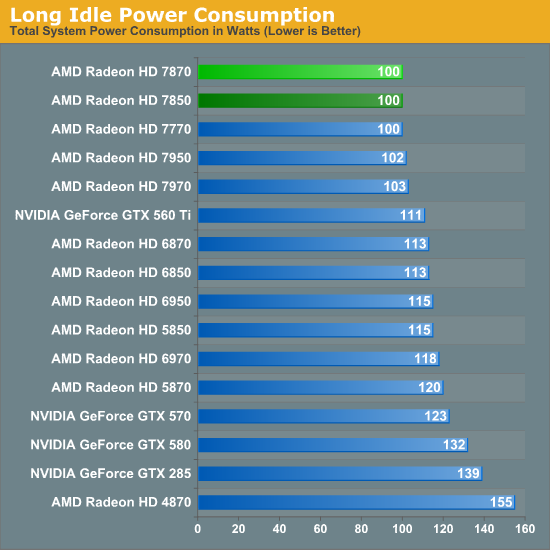
Long idle power consumption is virtually identical with the rest of the Southern Islands cards thanks to AMD’s ZeroCore Power technology. The next closest card is the GTX 560 Ti, and that’s at nearly 10W higher.
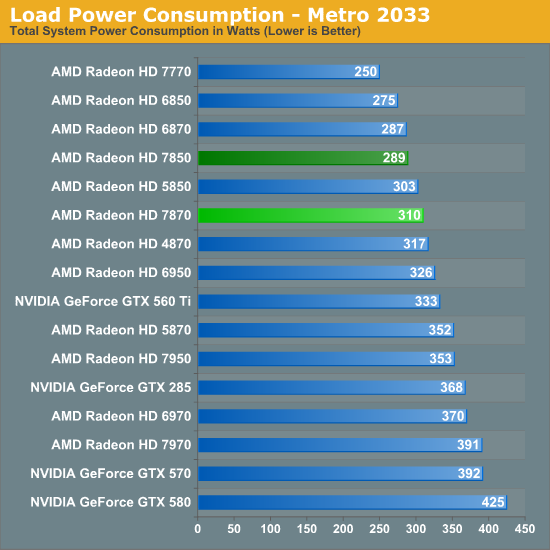
Moving on to load power testing, we have Metro 2033. Load power consumption here is about where you’d expect it to be, with the 7800 setups drawing more at the wall than the 6800 setups, but less than the 7900 and 6900 series. This is largely a consequence of performance, as the higher rendering performance of the 7800 series versus the 6800 series drives up CPU power consumption in order to generate more frames.
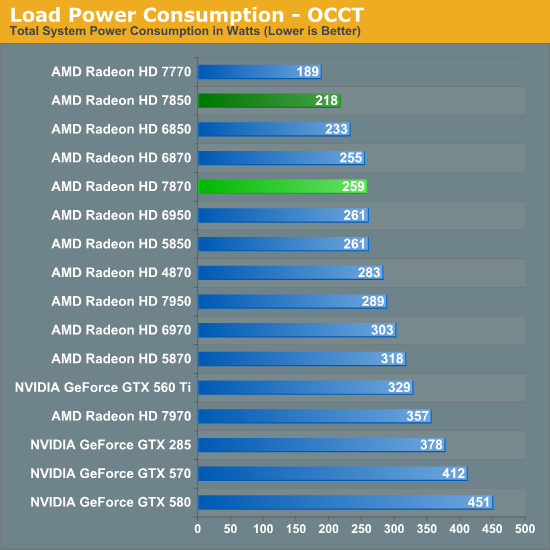
OCCT on the other hand gives us a more purified look at power consumption, and as you’d expect for 28nm it looks good. The 7870 ends up drawing only a few more watts at the wall compared to the 6870, showcasing the fact that the 7800 series is a drop-in replacement for the 6800 series from a power consumption perspective. The 7850 looks even better, capping out at 15W below the 6850, most likely as a result of PowerTune keeping the card firmly at 150W. Though it’s interesting to note that the measurements at the wall don’t perfectly align with the differences in PowerTune limits, with the 7850 drawing 30W more than the 7770 at the wall compared to a 50W PT difference, while the 7950 draws 30W more at the wall over the 7870 even though there’s only supposed to be a 10W PT difference.
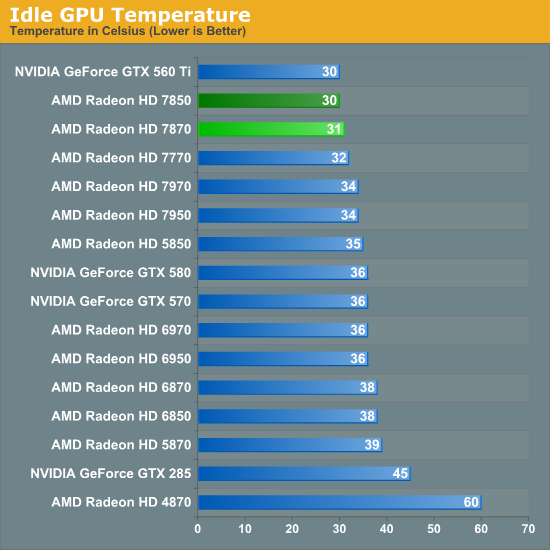
AMD’s latest generation blowers do quite well with idle temperatures and we can see it here. At 30C for the 7850 it’s every bit as cool as the GTX 560 Ti, while the entire 7800 series is around 5-8C cooler than the 6900.
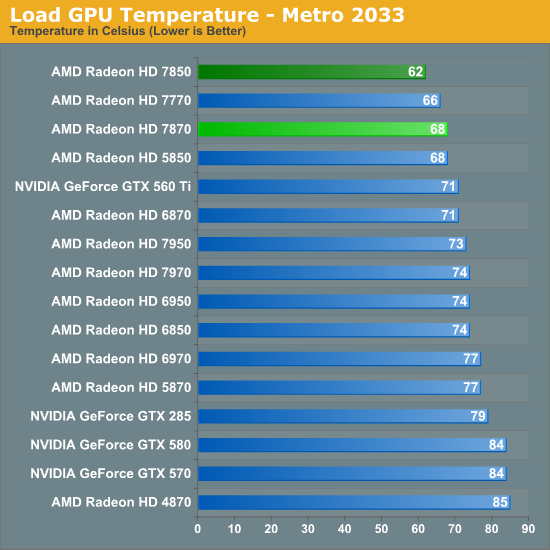
Under load, Metro temperatures are also quite good. At 62C the 7850 is the coolest card in this performance class, but keep in mind that it’s basically using an oversized cooler; retail cards will be open air coolers with much different characteristics. Otherwise at 68C the 7870 is still among the coolest cards, coming ahead of even the historically cool GTX 560 Ti, never mind the much hotter 6900 series.

Load temperatures climb under OCCT, but again the 7800 series is among the coolest temperatures we see. Here we see the 7870 peak at 73C, whereas its last generation counterpart would be at 80C and the GTX 570 at a toasty 87C.
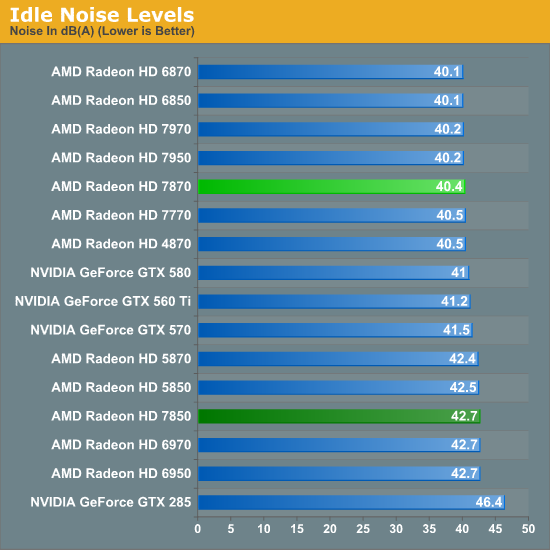
Moving on to noise testing, there are no major surprises at idle, with the 7870 hugging 40db. For whatever reason the 7850’s minimum fan state is roughly 200RPM higher than the 7870’s, but since no one will be using this cooler it’s not a significant result.
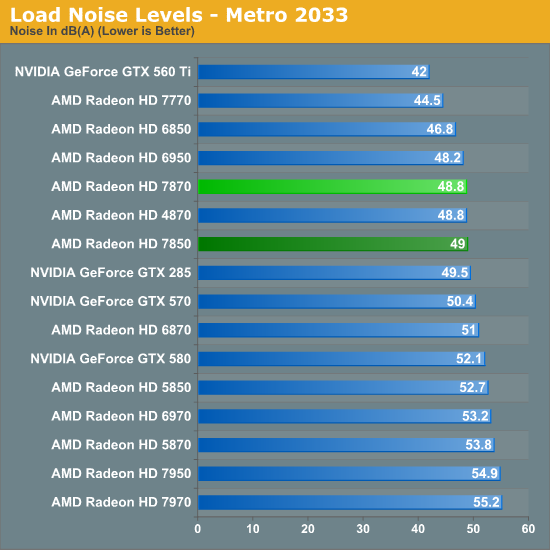
Consistent with AMD’s other 7000 series cards, we’re once again seeing the consequences of AMD’s aggressive cooling policies coupled with the use of a blower. At 48.8dB the 7870 is still quieter than the blower-based 6870, but it’s significantly louder than the open air cooled GTX 560 Ti, even though the latter consumes far more power and generates far more heat. This doesn’t make the use of a blower the wrong choice, but combined with aggressive cooling policies it does hurt AMD. The GTX 570, in spite of using much more power than the 7870, is only less than 2dB louder even though it too uses a blower.

Last, but not least we have our OCCT noise results. Unlike Metro the 7800 series does better on a relative basis here, but this is mostly because NVIDIA doesn’t have a power throttling system quite like PowerTune. At 51.9dB the 7870 is not the quietest card, but it still manages to beat the 6970 and the PowerTune-less 6870.
All things considered there are no great surprises here on a relative basis, as the 7800 series performs like we’d expect for a blower based sub-200W video card. Due to TSMC's 28nm process AMD greatly improves on their performance/power and performance/noise ratios with the 7800 series compared to the 6800 and 6900 series, while for their power class the 7800 series is slightly ahead of the pack on both power consumption and noise.
With that said, keep in mind that since most of AMD’s partners will be using open air coolers these results won’t be applicable to most retail cards. So for the temp/noise characteristics of retail cards you’ll want to look at individual card reviews when those start appearing later this month. This is particularly true for the 7950, where all of the retail cards will be using a different design than our sample.










173 Comments
View All Comments
DeViLzzz - Monday, March 5, 2012 - link
It is not the dumbest statement ever. Have you looked at multiple sites benchmarks ? Clearly a 2 GB 6950 Power Color flashed to a 6970 or a 6970 is worth keeping. Hardly an improvement over those situations for the price you would be paying for a 7870 and 7850.ExarKun333 - Monday, March 5, 2012 - link
Then you don't follow the graphic card industry very well at all.MadAd - Monday, March 5, 2012 - link
did i just read a different review? looking at this i did - Im on the 6950 and no theres not enough performance difference.also, comparing apples to oranges and saying theres a gain isnt going to work - if someones going to OC a 7*** then im sure they have also OC their 6***, so comparing a straight 6*** to the 7*** OC results and calling it a difference is smoke and mirrors.
cactusdog - Monday, March 5, 2012 - link
You guys dont get it. Why are you comparing the 7870 to a 6950? Should be the 6870 but even then The 7870 smashes the 6950 when overclocked. the 7870 performs like a stock 7970 when overclocked. You cant compare overclocking on the 6 series to the 7 series. The 7 series is the sandy bridge of GPUs.Why compare last gens high end to this gens mid range? If you have a 6950/6970 you should be looking at a 7950/7970. A 7950/7970 will give you 70% increase in performance when overclocked. AMD left heaps of overclocking headroom for easy overclocking.
Sure, the price is a little high now, but just wait a few weeks until Nvidia cards arrive and prices will come down. New tech is always a little expensive when it first comes out but no one is forcing you to buy now. Just wait a couple of weeks
Kiste - Tuesday, March 6, 2012 - link
"Why compare last gens high end to this gens mid range?"Because were introduced at the same price point. Video card names/numbers are completely arbitrary, you have to compare cards at a given price point.
xrror - Monday, March 5, 2012 - link
So I have one the the early 6950 2GB cards unlocked to 1536 shaders, and a 935/1275 overclock.Running at 1920x1200 in skyrim with the high resolution texture packs from Bethesda starts to lag.
Yes I'm being petty, but as a PC gaming smoe, I'm looking for a card that's under $300 that will dominate what I have.
I can't find a confident vote for a strong successor in the sub $300 range to replace my current card.
This makes me sad. Also with all the growing pains 69xx series had - and AMD's dumping of VLIW4 makes me pretty sure 69xx is a dead end for any future driver improvements.
Maybe I can sell my 6950 for $100 to subsidize a 79xx or a Kepler?
Zoomer - Wednesday, March 7, 2012 - link
I'll take it.mpschan - Monday, March 5, 2012 - link
I'd tend to agree with your assessment. Only those looking for bleeding edge performance should consider the upgrade to the 7900 series.The price/performance curve is a little disappointing, but not unexpected. This is what happens when you:
a) Move to a new process
b) Implement a new architecture
c) (Most importantly) Have no competition
They need to make their money back on the first two, and having no competition allows them to do that and then some.
But look at the thermals and power draw. Decreased power usage with a small gain in performance? Where have I seen that before ... oh I know, Intel!
Welcome to tick-tock folks. They took their process shrink and used it to allow them to draw less power, not tear up the performance charts.
This means the next generation on 28nm has room to expand. 1280 SP for the 7870 can be 1600 for the 8870. A 212mm2 die can be 300mm2. 190w can be 220w.
Ultimately the performance of these cards will come down to power drawn. The huge jumps in performance that we used to see existed because of drastically improving fabrication technologies combined with better ways of rendering screens. I think those days will be few and far between now.
arjuna1 - Monday, March 5, 2012 - link
You have a point, this generation is not worth spending the $$$ to "sidegrade". I don't kepler doing anything to change that other than forcing AMD to have decent prices.cactusdog - Monday, March 5, 2012 - link
How is a 7950/7970 a "sidegrade"?? To a 6950/6970? Its a massive performance increase. If you have a highend 6 series GPU you should be looking at highend 7 series. Not midrange.